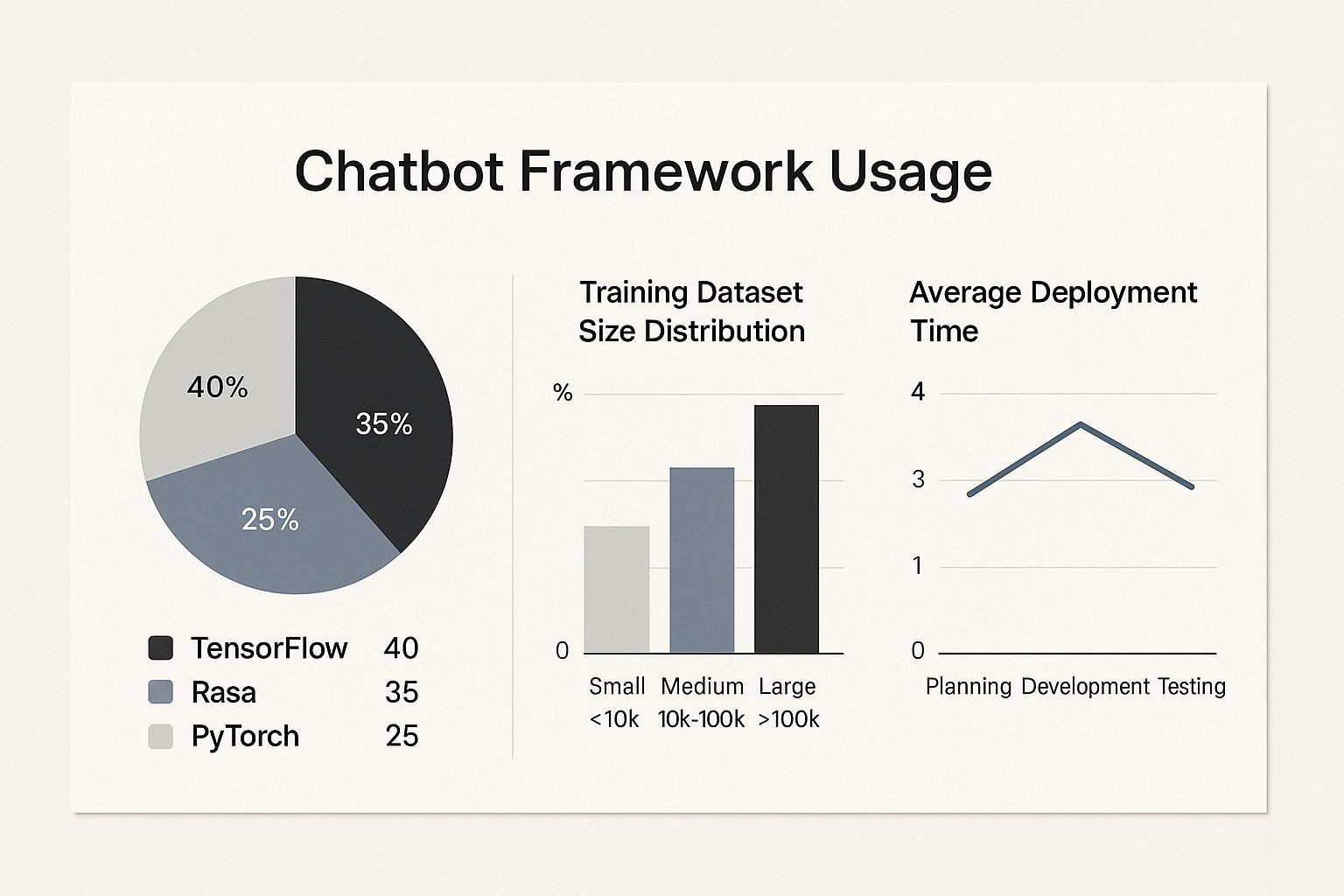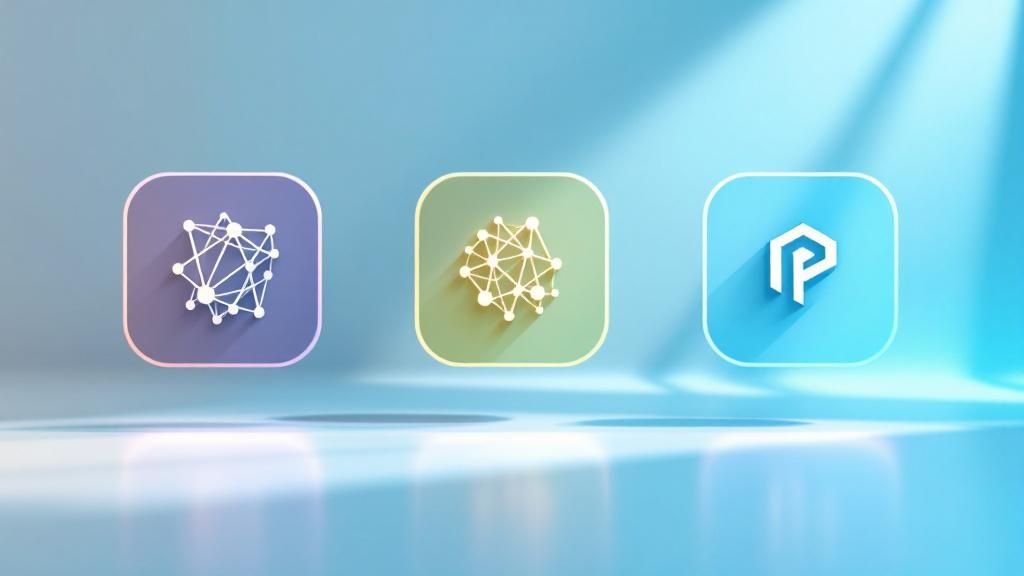Create Your Own AI Girlfriend 😈
Chat with AI Luvr's today or make your own! Receive images, audio messages, and much more! 🔥
4.5 stars

Understanding The 3 Key Pillars Before You Dive In
The AI chatbot scene is exploding right now. It’s exciting, but it can also feel a little overwhelming if you're thinking about building your own. I’ve chatted with a lot of developers who feel the same way, and here’s the consensus: despite the apparent competition, now is the best time to create a chatbot. The reason? So many chatbots out there just aren't very good. They’re generic, clunky, and easily forgotten. That leaves a massive opportunity to build something people actually enjoy using.
The secret is understanding the chatbot landscape and finding your niche. What makes your idea different? Are you building a simple FAQ bot for basic customer service, a complex AI companion like those you see on Luvr AI for deeper conversations, or something in between? Your goals and technical skills will heavily influence what you build. Asking these questions early on helps solidify your vision and inform your decisions.

This infographic visualizes some key data: framework usage (TensorFlow, Rasa, PyTorch), training dataset sizes, and average deployment times. Notice how Rasa is gaining popularity for its conversational AI focus. Also, see how much of the deployment time goes to planning? That highlights how important it is to have a clear vision from the beginning. This data really emphasizes the need for smart planning and choosing the right framework.
This growing interest is reflected in the market itself. The global AI chatbot market, valued at roughly $8.6 billion in 2024, is projected to hit $11.14 billion by 2025. That’s huge growth, and it shows just how quickly businesses are adopting AI. For a deeper dive, check out The Business Research Company's AI Chatbot Market Report.

This screenshot summarizes the key findings from the report, showing a clear upward trend. This strong market growth confirms the demand for chatbot solutions across diverse industries, creating a prime environment for new chatbot projects. There's plenty of space for well-designed, engaging chatbots to flourish.
Understanding Your Audience
Building a successful chatbot isn't just about the technical side of things. It’s about truly understanding your target audience, what they need, and the specific problems your chatbot can solve. Thinking about these key elements from the outset will greatly increase your chances of creating a chatbot that truly stands out from the competition.
To help you further in planning, I've put together a comparison table to illustrate the different types of chatbots available:
To help visualize the differences between various chatbot architectures, let’s take a look at this comparison:
Chatbot Types Comparison Matrix
A comprehensive comparison of different chatbot architectures, their capabilities, development complexity, and best use cases.
| Chatbot Type | Development Time | Technical Complexity | Customization Level | Best Use Cases |
|---|---|---|---|---|
| Rule-Based Chatbots | Short | Low | Limited | Simple FAQs, basic customer service |
| Retrieval-Based Chatbots | Medium | Medium | Moderate | Handling more complex queries, providing information |
| Generative Chatbots | Long | High | High | Creating dynamic and engaging conversations, personalized experiences |
| Hybrid Chatbots | Varies | Medium-High | High | Combining the strengths of different architectures to meet specific needs |
This table gives you a quick overview of the various chatbot types, from simple rule-based bots to complex generative models. Each type has its own strengths and weaknesses, and selecting the right one is crucial for your project's success. Think about your project's specific requirements and how each chatbot type aligns with them. Choosing the right architecture from the start can save you a lot of time and headaches down the road.
Picking The Right Tools Without Getting Overwhelmed
So, you're building an AI chatbot. Awesome! But picking the right tools can feel overwhelming. I've been there, drowning in a sea of options before even writing a line of code.
The trick is to cut through the hype. Forget the flashy marketing and focus on practicality. Some developers love platforms like Dialogflow, drawn to its user-friendly interface and pre-built components. It’s like a pre-fab house kit: quick and easy, but not as customizable.

This Dialogflow console screenshot shows how you design conversation flows and manage NLP components. The interface makes building complex conversational logic accessible, even without deep coding experience.
Other developers prefer the flexibility of building from scratch with Python libraries like ChatterBot and spaCy. This is like building brick by brick: more work upfront, but total control. Perfect if you need highly specific functionality, but it does mean a steeper learning curve.
Finding The Right Balance: Convenience vs. Control
It boils down to convenience versus control. Platforms like Dialogflow offer a smoother start and faster development, ideal for prototypes or simpler chatbots. If you need something fast for a specific business need, a platform might be the way to go.
But if you need serious customization or integration with unusual systems, Python offers a more robust solution, albeit more complex. Think about your existing skills, too. If you’re comfortable with Python, the custom route might feel more natural. Otherwise, a visual platform can be a lifesaver.
On the topic of platforms, the market share distribution is pretty interesting. ChatGPT currently dominates, holding roughly 76-80% of the global market as of mid-2025. Want to dive into the numbers? Check out the AI Chatbot Market Share data.
The Supporting Cast: Databases and APIs
Don't forget the supporting tools. These are the unsung heroes of your project. Your database needs to handle conversational data efficiently and scale as your users grow. Solid APIs are essential for integrating with external services and accessing valuable data. These supporting players can make or break your experience, so do your research! Look for good documentation, active communities, and responsive support.
Crafting A Chatbot Personality People Actually Want To Talk To
Building your own AI chatbot goes beyond just the tech stuff. It's about breathing life into a digital persona that genuinely connects with users. This is where the real magic happens – and, honestly, where a lot of chatbots miss the mark. A truly engaging personality isn't about cheesy jokes or forced quirkiness. It's about being helpful in a way that feels authentic and human. I've seen this firsthand: a well-crafted personality can transform a chatbot from something people ignore into something they actively seek out.
So, how do you create this conversational spark? It all begins with consistency. Think deeply about your chatbot's purpose. A customer service bot needs to project helpfulness and efficiency, while a chatbot designed for entertainment can have a more playful, relaxed tone. You might find this interesting: how to match AI voice with personality. Whatever voice you choose, sticking with it, even when the conversation takes unexpected turns, is key. This prevents your bot from feeling disjointed and, well, a little creepy.
Designing Engaging Conversation Flows
Next up, think about the flow of your conversations. It’s essential to map out how interactions are likely to unfold. Anticipate user questions and prepare responses that feel natural and helpful. Imagine you’re chatting with a real person. You wouldn't just bark one-word answers or suddenly switch topics, right? The same goes for your chatbot.

This screenshot from Wikipedia shows some of the many platforms where chatbots live. Seeing this variety highlights how important it is to tailor your chatbot’s personality to the specific context. A formal tone that works well on a business website might fall flat on a casual messaging app.
But even with the best planning, users will always surprise you. They'll ask unexpected questions or phrase things in odd ways. That’s where fallback responses become your best friend. Instead of a blunt "I don't understand," craft responses that gently nudge the user back on track or suggest alternative ways to ask their question. Something as simple as "Could you rephrase that?" or "I'm still learning, could you try asking another way?" can make a big difference. It makes the interaction feel like a collaboration, not a dead end.
Maintaining Context and Building Relationships
Remember, real conversations rarely consist of single questions and answers. Your chatbot needs to maintain context throughout the interaction. This means remembering what’s been said earlier so it can provide relevant responses later on. If a user asks about flights to London and then later asks about hotels, your bot should offer hotels in London, not suddenly switch to Paris.
Finally, and this is a big one, shift your thinking from transactional exchanges to building actual relationships. Think about the psychology involved in human-AI interactions. People are much more likely to engage with a chatbot that feels like a helpful partner rather than just a glorified search engine. This means crafting interactions that are not only informative but also rewarding. A simple "Glad I could help!" or "Is there anything else I can assist you with?" adds a touch of personality and makes the interaction feel less mechanical. It fosters a sense of connection and encourages users to come back again. By focusing on these elements, you can create a chatbot that truly resonates with people and keeps them coming back for more.
Building Your Chatbot From The Ground Up
So, you want to build a chatbot? Awesome! It's a hands-on process, and I'm excited to share some practical tips from my own experience. Forget rigid step-by-step tutorials; this is about real-world advice from someone who's been there.
Setting Up Your Development Environment
Think of setting up your development environment like prepping a kitchen before a big cooking session. A messy workspace is like a chaotic kitchen – you'll spend more time hunting for things than actually creating. When I first started building chatbots, I had files scattered everywhere. Talk about frustrating! Now, I swear by organized folders: one for data, one for training scripts, one for testing modules, and so on. This simple trick saves tons of time.
Training With Quality Data
Your data is like the ingredients for your chatbot recipe. Low-quality ingredients mean a subpar final product. I learned this the hard way on a project where the initial training data was a mess. The chatbot's responses were all over the place, and it constantly misinterpreted user requests. Cleaning up the data was a game-changer, and the chatbot’s performance skyrocketed. Clean data is the foundation of a smart chatbot.
Natural Language Understanding (NLU)
NLU is the magic that lets your chatbot understand the meaning behind what users say, not just the words themselves. It's the difference between reacting to keywords and understanding context. A powerful NLU model handles slang, typos, and different phrasing with ease, making the interaction feel much more natural. Want to dive deeper into NLU? Check out this guide on fine-tuning GPT-3 for chatbot intent recognition.
Practical Coding and Debugging
When you're coding your chatbot, a version control system like Git is a lifesaver. It's like a giant "undo" button for your entire codebase, letting you experiment and easily revert to earlier versions. Trust me, it's rescued countless projects, especially during those late-night coding binges. And speaking of late nights, debugging is part of the game. Don't get discouraged by bugs. See them as opportunities to learn. I've learned more from squashing bugs than I have from writing perfect code.
This screenshot showcases a web chat interface built with Microsoft’s Bot Framework. Notice the structured messages and the potential for integration with other services. Thinking about the user interface is just as important as the backend code.
Optimization and Responsiveness
As your chatbot grows, you'll need to keep it running smoothly. Nobody likes a slow chatbot! In one of my projects, I used caching to store frequently accessed data. This dramatically reduced response times, especially for common queries. It's like having a well-organized pantry – you can grab what you need quickly.
To help you choose the right framework, I've put together this comparison table:
Development Framework Feature Comparison Detailed comparison of popular chatbot development frameworks showing features, pricing, learning curve, and integration capabilities
| Framework | Free Tier | NLP Capabilities | Integration Options | Learning Curve | Best For |
|---|---|---|---|---|---|
| Dialogflow | Yes | Intent recognition, entity extraction, sentiment analysis | Google Cloud, various messaging platforms | Moderate | Conversational AI, customer support |
| Rasa | Open Source | Customizable NLU pipelines, dialogue management | REST APIs, various messaging platforms | Steep | Complex chatbots, research |
| Microsoft Bot Framework | Yes | LUIS for NLU, dialogue management | Azure services, various messaging platforms | Moderate | Enterprise chatbots, integrations |
| Amazon Lex | Yes | Automatic speech recognition, NLU | AWS services, various messaging platforms | Moderate | Voice-enabled chatbots, AWS ecosystem |
This table highlights the key differences between some popular frameworks. Choosing the right one depends on your specific needs and project goals.
Whether you’re building a customer support bot or a creative companion like the ones on Luvr AI, these fundamentals will help you create something truly engaging. Remember to have fun with it! Experiment, iterate, and refine your chatbot until you've built something special.
Testing And Launching Without The Panic
Here's the thing: your chatbot will never be perfect before launch. And that's okay! What really matters is getting something functional out there and improving it as you go. I've launched tons of chatbots, and the most successful ones were the ones I wasn't afraid to release, even if they weren't completely polished.
So, how do you test effectively and launch confidently? Let's talk strategy.
Testing Strategies That Actually Work
Forget those generic testing checklists. You need strategies that uncover real issues before your users do. My go-to is conversation flow testing. Put yourself in your user's shoes and try to break things. Ask bizarre questions, give unexpected input, and see how your chatbot handles the chaos. This is where you'll find those awkward replies or logic errors that can make your bot feel clunky.
Another essential step is stress testing with real people. Grab some friends, colleagues, or beta testers who aren't afraid to push your chatbot to its limits. Their fresh perspective will uncover things you've missed. I once had a beta tester find a huge bug in a payment system that I had totally overlooked. They saved the day!

This screenshot shows the Azure Bot Service interface. Check out the different channels and integrations! This really highlights why testing across various platforms is so important. You want your chatbot to provide a smooth experience, no matter where users are interacting with it.
Staging and Beta Testing: Mirroring Real-World Conditions
Before launching publicly, set up a staging environment. This should mirror your production environment as closely as possible. Think of it as a dress rehearsal for your chatbot. It lets you test integrations, database connections, and overall performance in a realistic setting.
Then, it's time for beta testing with a small group of users. This gives you invaluable feedback on everything from conversation flow to the user interface. Beta testers are great for pointing out where your chatbot's personality falls flat or where the conversation feels unnatural. Their input is crucial for polishing your chatbot before the official launch.
Deployment and Monitoring: Launching With Confidence
When you're feeling good about your chatbot, it's time to deploy! Choose a platform that works for your target audience. If you're building an AI companion like the ones on Luvr AI, look for a platform that focuses on privacy and personalized experiences.
After launch, make sure you have monitoring and analytics in place. This tells you how your chatbot is performing in the real world. Track important metrics like conversation length, user engagement, and fallback rates. This data will be your guide for continuous improvement.
Security and Post-Launch Optimization
Security is essential! Protecting user data is non-negotiable. Make sure you have solid security measures in place to safeguard sensitive information.
And remember, launching is just the beginning. The real magic happens with post-launch optimization. Use user feedback to continually improve your chatbot. This is how you build something that not only meets but exceeds user expectations. Did you know North America leads in AI chatbot adoption, with about 35% of the global market? This is largely due to strong tech infrastructure and high enterprise use. For more on these trends, discover more insights on AI chatbot statistics. By staying adaptable and responsive to user needs, you'll ensure your chatbot remains relevant and valuable in this dynamic world of AI. Building a chatbot is a journey of learning and improvement.
Adding Advanced Features That Actually Matter
So, you've got your basic AI chatbot up and running. High five! But now comes the really exciting part: layering in those extra features that take a good bot and make it truly great. In my experience, it all boils down to user experience. Forget just throwing in fancy tech for the sake of it; focus on features that genuinely make the interaction better.
Multi-Language Support and Voice Integration
For starters, I almost always consider multi-language support. It's essential in our globalized world. But simply running your text through Google Translate won't cut it. You really want your chatbot to sound natural, not like some clunky machine. On one project, I went as far as incorporating language-specific slang and idioms. It was a minor tweak, but it made a huge impact on user engagement. People actually felt like they were talking to someone who got their culture.
Voice integration is another game-changer. This can create a much more immersive experience, especially for AI companions. However, a robotic, monotone voice can instantly ruin the vibe. Spend some time finding a voice that truly matches your chatbot's persona. Think carefully about the tone, the pace, and the overall feel. This can significantly improve the human-like quality of your interactions.
Sentiment Analysis and Rich Media
Sentiment analysis is another must-have. It lets your chatbot understand the emotional tone of the user's messages—are they annoyed, thrilled, or just neutral? This is where your chatbot can truly shine. Imagine a chatbot that can respond empathetically to a frustrated user or share in their excitement. That creates a real connection. I implemented this on a customer support bot, and it dramatically lowered customer frustration. The bot could sense when someone was upset and adjust its responses accordingly.
Don't limit yourself to just text. Think about using rich media like images, GIFs, and videos. They can add so much to the conversation. For example, in my work on Luvr AI, we've found visual elements are fantastic for enriching romantic role-play scenarios.
Interactive Elements and External Service Integrations
Adding interactive elements like buttons, quick replies, and forms can also make the conversation much smoother and more user-friendly. But a word of caution: don't go overboard. Too many buttons can become overwhelming. Remember, the goal is to simplify, not complicate things.
This screenshot from the Rasa website shows their open-source platform for building conversational AI. The clean layout highlights a code-first approach, which is perfect for developers who want more customization control.
Finally, consider integrating with external services. This is where you can add real value. Imagine your chatbot booking appointments, ordering food, or pulling real-time data from external APIs. On one project, I integrated a chatbot with a weather API. Users could simply ask about the weather and get instant, personalized replies. These integrations turn your chatbot from a simple chatterbox into a genuinely useful assistant. You might be interested in: 10 Best AI Girlfriend Features on Luvr AI.
Advanced NLP and Machine Learning
As you're building, don't be afraid to dive into advanced NLP techniques. These give your chatbot the ability to understand context, handle ambiguity, and have more complex conversations. Look into things like named entity recognition and coreference resolution.
And don't forget the magic of machine learning. It allows your chatbot to constantly learn from every interaction, refining its responses and understanding over time. That means less manual tweaking for you and a more dynamic, evolving chatbot. By using these advanced features, you can build a chatbot that truly shines. Just focus on what your users need, and you'll create something amazing.
Your Chatbot Success Roadmap
Building an AI chatbot is like planning a road trip. It’s not just about jumping in the car and hitting the gas. You need a map, you need to know where you're going, and you need to pack the right supplies. The same goes for your chatbot. A well-defined roadmap is what separates a successful chatbot from one that gathers digital dust.
Technology Choices That Scale
Picking the right tech is essential. Think of it as choosing the right vehicle for your road trip. A compact car might be fine for a weekend getaway, but if you’re planning a cross-country trek, you’ll need something more robust. Similarly, your chatbot's tech stack needs to handle growth. If your chatbot takes off, can your database handle the surge in users? Will your Natural Language Processing (NLP) framework keep up with complex conversations? Consider these questions early on.
Choosing a scalable database, like MongoDB, or a cloud-based solution can save you headaches down the road. From my experience, starting with a flexible framework is key. You want something that can adapt as your chatbot evolves.
Conversation Design That Keeps Users Engaged
Tech is important, but conversation design is where the magic happens. This is the personality of your chatbot, the voice that users interact with. Think about your favorite apps or websites. What keeps you coming back? Chances are it's not just the functionality, but the overall experience. A chatbot with a genuine and engaging personality will keep users interested. A boring, robotic chatbot? Well, let’s just say it won't win any popularity contests.
I’ve found that giving your chatbot a backstory, even a simple one, can make it feel more relatable.
Realistic Timelines and Budget Considerations
Let’s be real about timelines. Building a simple FAQ bot is like a quick trip to the grocery store. You can probably knock it out in a few weeks. But building a complex AI companion, like the ones on Luvr AI, with features like multi-language support and sentiment analysis, is more like planning a trip around the world. It’ll take longer. Be realistic with your timeline and factor in extra time for unexpected bumps in the road.
Budget is also a factor. Free and open-source tools are great for getting started, but advanced features might require paid subscriptions. Be honest about your budget and research different pricing models. There are options out there for every budget.
Measuring Success and Overcoming Challenges
Success is more than just user numbers. It's about engagement. Are users actually interacting with your chatbot? Are they finding what they need? Are they returning for more? These are the questions you should be asking.
And let’s face it, building a chatbot isn't always a smooth ride. You’ll run into bugs, unexpected user behavior, and the occasional frustrating integration. The key is to stay flexible. Join online communities, connect with other developers—don’t be afraid to ask for help. It's all part of the journey.
Maintaining and Evolving Your Chatbot
The chatbot world is constantly evolving. New tech appears, user needs change, and your chatbot needs to keep up. Regular updates, incorporating user feedback, and staying informed about the latest advancements are vital.
It’s interesting to see how the B2B sector is adopting chatbots even faster than B2C. Businesses are using them for everything from lead generation to internal support. The real estate industry seems to be leading the way, followed by retail and e-commerce. Check out some of the interesting stats on AI chatbot statistics.
Your chatbot is an investment. With smart planning and a focus on the future, you can make sure it continues to deliver value. So, what are you waiting for? Start building!
Ready to dive into the world of immersive AI characters? Explore the possibilities with Luvr AI.



